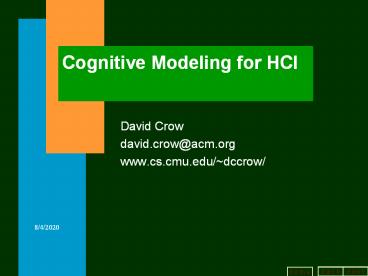Cognitive Modeling for HCI - PowerPoint PPT Presentation
Title:
Cognitive Modeling for HCI
Description:
Video games (John, Vera, & Newell, 1993) b a c k. n e x t. h o m e. 7/8/09 ... Cognitive walkthroughs. A design technique. b a c k. n e x t. h o m e. 7/8/09 ... – PowerPoint PPT presentation
Number of Views:1545
Avg rating:3.0/5.0
Title: Cognitive Modeling for HCI
1
Cognitive Modeling for HCI
- David Crow
- david.crow_at_acm.org
- www.cs.cmu.edu/dccrow/
2
HF vs. HCI
- Human Factors
- discovers and applies information about human
behavior, abilities, limitations and other
characteristics to the design of tools, machines,
systems, tasks, jobs and environments for save
comfortable and effective human use (Sanders
McCormick,1987, pp..5) - Human-Computer Interaction
- is concerned with such issues as users
capabilities and preferences and the degree to
which interfaces support their activities.
3
Cognitive Modeling
- Is a form of theory
- Uses empirical results
- Develops analytical models that make quantitative
predictions about a users performance
4
History
- Information processing concepts borrowed from
computer science and engineering - During WWII, complex military displays analyzed
to improve their design - Led to mathematical models of human behavior
(Fitts Law, Hick-Hyman Law)
5
History (continued)
- Cognitive Psychology first described by Neisser
in 1967 - Appearance of the journal of Cognitive Psychology
in 1970 - The role of the environment
6
Applied Cognitive Psychology
- Carnegie Mellon University in the early to
mid-1970s - Moved to XeroxPARC
- Culminated in Card, Moran Newells (1983) The
Psychology of Human-Computer Interaction
7
Psychology of HCI
- Theory-based, in the sense of articulating the
mechanisms underlying the observed phenomena - Hard Science
- Engineering theories of the user
- Task analysis, calculation and approximation
8
Cognitive Models
- Constrain the design space
- Estimate total task time
- Estimate training time and documentation
- Identify complex, error prone stages of the task
9
Model Human Processor
- An idealized information processing model of
human perceptual, motor and cognitive systems - Describes behavior using 3 processors, 4
memories, 19 parameters and 10 principles of use
10
The GOMS Model
- a formal representation of routine cognitive
skill - a detailed description of knowledge required by
an expert user to perform a specific task without
error - a usefully approximation of the processes
underlying human behavior
11
GOMS
- Goals
- what the user wants to accomplish
- Operators
- the actions a user is able to take
- Methods
- well-learned subgoals and operators
- Selection rules
- guidelines for deciding between multiple methods
12
Why use cognitive models?
- It is useful to analyze the knowledge of how to
do a task in terms of goals, operators, methods
and selection rules. (John Kieras, 1996) - Validated engineering models of human performance
13
Why use cognitive models? (continued)
- Provide a functional model of the task
- Specific information includes
- Tricks of the trade
- Perceptual skills
- Big picture
14
Where have cognitive models been used?
- Production systems, GLEAN (John Kieras, 1996),
JIAA (Crow, 1998) - Text editing (Card et al., 1983 John, 1996)
- Phone operators (Atwood, Gray, John, 1995)
- Video games (John, Vera, Newell, 1993)
15
How have cognitive models helped?
- Identification of potential errors
- Purchase of new workstations
- Prediction of learning time
16
Where does GOMS fit?
- Product Design is to develop a product that has
- Utility
- Usability
- Acceptance
- Salability
- Functional Level, Documentation, Keystroke
Analyses
17
What GOMS is not!
- Usability Testing
- Interviewing technique
- Naturalistic observation
- Heuristic evaluation and other checklist
- Cognitive walkthroughs
- A design technique
18
Extensions
- New Input Devices
- Effects of fatigue and stress
- Individual differences
- Collaborative cognitive models































